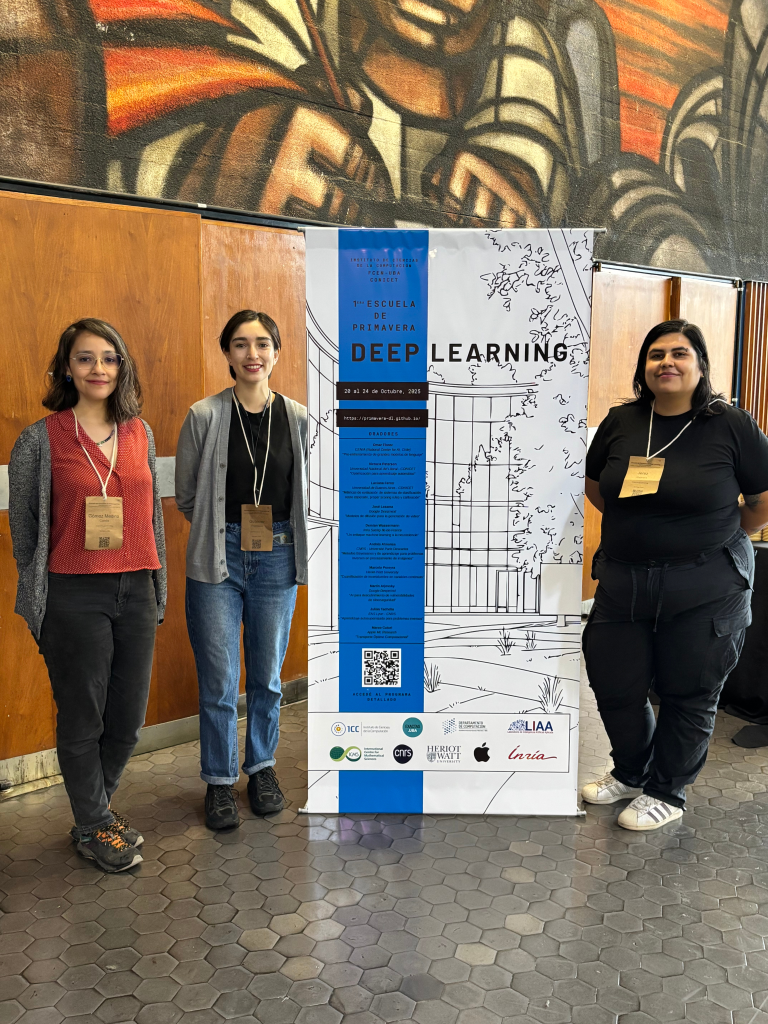Between October 20 and 24, the first Deep Learning School was held at the Faculty of Exact and Natural Sciences of the University of Buenos Aires (UBA). Deep learning is an area that uses multilayer neural networks to create artificial intelligence (AI) applications and products. This field has experienced exponential growth in recent years, which is why this first school was taught in Spanish, as a result of the great interest shown by the research community in Latin America.
The event sought to train and update student and research communities on the main problems and cutting-edge methods, such as machine learning system evaluation, natural language processing and large language models, fairness and ethics in artificial intelligence methods, biomedical signal processing, inverse problem solving with supervised and unsupervised learning methods, and uncertainty quantification methods.
The course received nearly 800 applicants, of which more than 200 were selected, and was sponsored by prestigious institutions such as the French National Institute for Research in Computer Science and Control (INRIA), Apple, and the International Centre for Mathematical Sciences in Edinburgh, among others.
Representing CopernicusLAC Chile were Camila Gómez, remote sensing specialist in the Land Cover and Use (LCU) service; Francisca Gutiérrez, remote sensing specialist in the Urban Atlas (UA) service; and Gabriela Jerez, artificial intelligence engineer. who presented the Center’s progress in terms of the services it offers, sharing the methodologies applied to the published services and also the experiences of applying AI to satellite data, strengthening collaboration networks with specialists and researchers in the region.
This experience provided a deeper understanding of how technical knowledge about hardware specifications and capabilities—particularly graphics processing units (GPUs) and distributed computing environments—directly influences the optimization and performance of deep learning models. Gabriela Jerez explains that “the idea is to consolidate collaborative work between the areas of technological infrastructure and applied research, so that artificial intelligence solutions are developed taking into account both computational architecture and scientific requirements. This allows for greater efficiency, reproducibility, and scalability in modeling processes.”
One concept discussed at the Deep Learning School is that of “hallucinations,” which correspond to results generated by a model that are not based on actual evidence within the training data, i.e., inferences that the model “imagines” without empirical support. “At CopernicusLAC Chile, our models for generating Land Cover and Land Use maps and Urban Atlas are designed to avoid this type of error by using strict confidence thresholds on the probabilities (posterior) obtained during classification. This means that the system only considers valid those pixels whose prediction has high statistical reliability. In other words, the model does not invent information: if the data does not exist or does not meet the certainty standard, it is not included in the final result,” explains Camila Gómez.
The School featured several talks, among which Francisca Gutierrez highlights Victoria Peterson’s talk on “Optimization for Machine Learning.” “The presentation addressed advanced optimization strategies in deep learning models, focusing on parameter adjustment to improve computational efficiency without sacrificing model accuracy. This type of approach is applicable to the models we use for CopernicusLAC Chile services,” comments the Remote Sensing specialist at the Urban Atlas (AU) service.
The representatives of CopernicusLAC Chile, Camila, Francisca, and Gabriela, conclude that participation in international events within the region is essential not only to disseminate the work carried out by CopernicusLAC Chile, but also to learn from the knowledge and experiences of other scientific communities. “Spaces like this strengthen collaboration between Latin American countries, promote the exchange of practices and methodologies, and allow the team to incorporate technological innovations that enhance the development of local capabilities in Earth observation and applied artificial intelligence,” reflects Gutiérrez.




